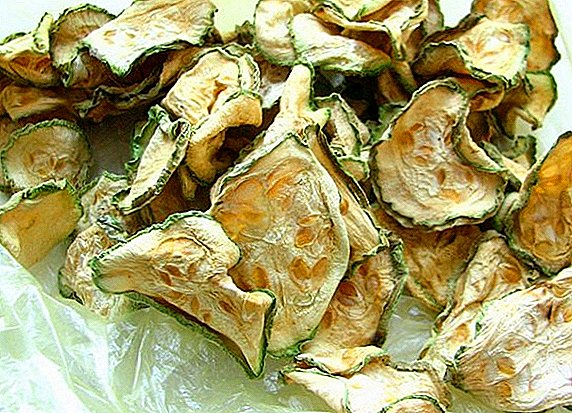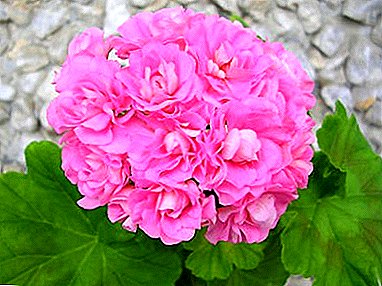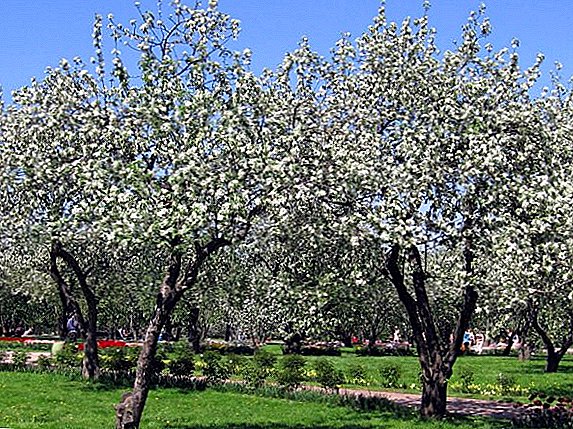 In the process of caring for fruit trees, pruning of the crown plays a significant role. Removing the sick, weak branches and organizing the access of sunlight to the inner part of the garden will not only create a cozy atmosphere, but also contribute to increased yields. That is why worth knowing about all the nuances of pruning a tree, but in this case we'll talk about the apple tree.
In the process of caring for fruit trees, pruning of the crown plays a significant role. Removing the sick, weak branches and organizing the access of sunlight to the inner part of the garden will not only create a cozy atmosphere, but also contribute to increased yields. That is why worth knowing about all the nuances of pruning a tree, but in this case we'll talk about the apple tree.
Why do I need spring pruning of apple trees
With the advent of spring in nature begins the natural process of its renewal, so all plants are particularly susceptible to transplanting, splitting or pruning. However, as far as fruit trees are concerned, it is at this time that they best tolerate interfering with the integrity of the structure of their branches and the trunk. However, in order to properly perform this procedure, you should take into account many important nuances, which will be discussed later. 
Why interfere with the plant’s natural life cycle and remove any parts of it? The timely pruning of the apple tree contributes to the formation of the crown, in which the top point of the continuation branch of the central conductor is obtained located above the rest of the branches on the tree. In this way, the crown can continue its normal formation and will not become too thick.
Together with the old and frozen frozen branches, you can remove entire colonies of pests from your tree, reducing the need to use chemical remedies to combat them. In addition, fruits ripening on a branch well lit by the sun, as a result, will be larger and better colored, with a higher content of sugars and dry matter. That is, if you want to get regular and abundant crops of apples, then correct pruning of apple trees in the spring is simply necessary.
If you want your apple tree to bring a bountiful harvest, find out how to deal with apple pests.
Optimum time for spring pruning
Gardeners consider the most suitable terms for pruning apple trees the beginning of spring, since it is during this period that the tree awakens from sleep and is at rest (sap flow is slow or completely absent). The ideal temperature for the procedure is considered to be no more than -4 ° C (typical for the beginning of March), since at lower temperatures, the fragility of the tree bark increases and is easier to damage. 
Important! Apple trees calmly tolerate the pruning process, if before the arrival of winter frosts the soil under the trees was properly treated, fertilized with nutrients and watered well.When spring pruning trees, you can remove both very young and large perennial shoots or frozen branches. For comparison, in the autumn period, pruning of apple trees is carried out in order to finally form their crowns, without any damage, cutting out new shoots. In springtime, such a result cannot be achieved, because due to the active sap flow and brittleness of the bark, the branches can simply shrivel (they are ruined by the juice flowing from the bark cracks).
Some gardeners prune apple trees in the summer, but this is permissible only for the upper part of the crown, which will help the sun's rays reach the fruit. In the southern regions, pruning of apple trees is carried out even in winter, when they are at rest. However, in other climatic conditions, this procedure is prohibited, because during severe frosts the bark becomes very brittle and you can easily damage the tree. 
A set of garden tools for pruning trees
It is easy to guess that in order to carry out the correct pruning of fruit trees, it is necessary to prepare a special tool, which should be sharp enough (this will help minimize the damage caused by pruning). Among the most common types of such inventory are pruning shears and saws and the choice of a particular instrument depends on the thickness of the branches to be removed. At the same time, you should not use tools with a ratchet mechanism, since all cuts should be extremely smooth and performed with just one movement. Also not suitable for such work and standard saw for construction tasks, as it can cause a large number of unnecessary mechanical damage.
The ideal inventory when pruning apple trees in the spring will be special saw for branches, with a small comfortable curvature and a sheet tapering towards the end (novice gardeners can easily cope with it).
If the tree is too high and it is difficult to reach the upper branches, a shank cutter will help to do the work. With it, you can remove even the most inaccessible branches, because the shears are not for nothing supplemented with a long barbell (the mechanism is activated by means of ropes and levers). 
Important! The blade of any tool must be absolutely clean, without any rust. It is best to treat it with an antiseptic or alcohol before starting work, which will help prevent the spread of fungal infections (if possible, a similar disinfection should be carried out after each tree).
Differences in pruning old and young apple trees
The nuances of pruning apple trees in the spring depend on various factors, but first of all, when choosing a specific scheme of work, it is worth determining which tree is young, fruitful or already old. If in the first case, all activities are aimed at improving the quality of the crop and the further development of the tree itself, then if you remove branches from old plants, you will be able to significantly rejuvenate them, which will prolong the fruiting process for a few more years.
In any case, regardless of age, it is imperative to get rid of old, frozen, sick and dried shoots.
Check out the most common varieties of apple trees: Uralets, Pepin saffron, President, Champion, Bashkir Beauty, Berkutovskoe, Currency, Sun, Northern Synaph, Candy, "Ranetki", "Semerenko", "Orlinka", "Orlovim", "Zvezdochka", "Kandil Orlovsky", "Papirovka", "Screen", "Antey", "Antonovka", "Uslada" and "Melba".

Scheme pruning young trees
For the first time planting an unbranched one-year-old apple tree sapling, it should be pruned at a distance of 1 m from the soil level, which will ensure the rapid formation of lateral shoots (this year). In that case, if you already have a branched one-year-old sapling, you need to remove all the side shoots, while maintaining a part 70 cm above the ground. Among the high branches pruned are those that form an acute angle with the trunk. Shoots that are at a wide angle (about 90 °) should be shortened to the third or fifth bud.
Important! A wide angle of escape means that in the future the tree will have a solid crown, and the horizontal position of the branches promises generous yields.The constituent parts of a two-year plant are the stem and several shoots extending from it. Among these branches, you need to leave 3-5 of the most developed specimens with wide angles, which will later become the main branches of the apple tree, and the rest should be completely removed.

The central conductor is usually formed above the most developed kidney, from which a vertical shoot will develop (it should be 4-5 buds above the skeletal branches). All other branches are cut so that the lower ones are longer (up to about 30 cm), and those that are taller are shorter. This is how the basic skeleton of a strong and rounded crown of a young apple tree is formed.
The next 3-5 years, young trees are better not to touch, otherwise there may be delays in fruiting. Minimal intervention is allowed if removal of broken and diseased branches is required. They need to be removed at the very base, and in the event that the tree starts to grow too actively, you can further shorten the conductor so that the tiers of the branches are not located too far from each other (just do not forget that in any case it remains the main one).
In order to form the correct tree crown, besides trimming by gardeners, other methods are used: for example, You can change the direction of the slope or the growth of a branch. The branch angle is changed by installing a spacer between the branch and the trunk. You can also tie a branch to a peg hammered into the ground, pulling it from the base. Empty crown areas are filled by changing the direction of growth of the branches.
Read also all about correct pruning of apple trees in spring and autumn.

Pruning fruit trees
Pruning apple trees in spring - a mandatory event for fruit-bearing trees, and when you start it, you already know from the previous sections. Tall varieties in the period of full fruiting form growths of about 30-40 cm, but without a "refreshing" annual pruning it will not always and over time they weaken, and the harvest of the inner parts of the crown will quickly be on its periphery. While the tree is still producing good fruit, but the increments are already beginning to decline (shorten by 20-25 cm) - it's time to pruning. First, the branches are removed until the 2-3-year-old wood, and then the old, weakened annuli are completely cut out (they practically do not yield crops, but consume a lot of nutrients).
Of course, the branches that thicken the crown are subject to regular removal, since it is necessary to constantly maintain good lighting around the perimeter, which will increase growth and stimulate fruiting. In dwarf varieties grafted on low-growing rootstocks, shoots growth is reduced much faster. In order to increase their growth and get large fruits, the rejuvenating pruning of apple trees should be started very early in the spring and continue to use the described scheme on a regular basis.
Did you know? In Ancient Rus, the Garden of Eden on all images was represented only by apple trees, since Adam and Eve had been bitten off the fruit of this particular tree.

Pruning an old apple tree
Pruning of old trees has its own characteristics. It is performed in several ways, but in any case it is not necessary to drastically reduce the size of the tree. This can lead to severe frosting, even if the winters in your area are not too severe.
One way of pruning branches provides for their shortening every 2-3 years by 1-2 m, however, given that the fruiting of old apples is mainly concentrated on the periphery of the crown, such manipulation will adversely affect the yield and reduce the size of the tree. You need to be prepared for the fact that it will take about 6-7 years to reduce branches from 10 to 3 meters, and all this time you should not wait for abundant harvests.
The second method of pruning is based on shortening the skeletal and semi-skeletal branches by 3–4 year old wood. This option is suitable for pruning trees, in which there has been no growth for 2-3 years. In very old plants, skeletal and semi-skeletal branches are often shortened by 5-7 or even 10-year-old wood, and fruit branches by more than half of their length. 
The third method, which is suitable for pruning old apple trees, is to carry out this procedure in several stages (years). Each time, gardeners cut out 1-2 thick non-bearing branches, the removal of which is determined in advance. Over time, the crown thickening will decrease, and with it, sick, broken branches and sharp forks will be removed from the tree.
In general, the trimming procedure is as follows:
- first, shoots are removed from the root of the tree and growing from the trunk;
- then the branches growing in a downward direction are cut;
- further, shoots directed to the trunk are removed;
- intersecting branches are cut off;
- all specimens that grow close to each other are cut out (the most promising branch should be left);
- the lower branches are cut off at the forks;
- cleaned top branches.
Important! In any case, the main thing - Do not cut off too much of the branch mass, because if the tree loses more than the recommended third, it can easily die or become just a decorative ornament at the dacha.

Post-trimming activities
Proper implementation of the pruning procedure provides not only a strict adherence to all the rules for the removal of branches on apples of different ages, but also the competent completion of this process in each individual case. Do not forget that the cuts are wounds on the body of the tree, therefore they need to be processed immediately. As the "iodine" is used a special mastic for garden work or garden var. If you do not have either one or the other, the usual oil paint will be suitable, to which you must first add a fungicide (copper sulfate). So you block the road flowing juice, and the tree will be able to recover faster.
Moreover, such a treatment will help protect the plant from various diseases and infections, which often penetrate into the tree through a fresh cut. Only one infected branch can destroy the entire apple tree, so do not be negligent to treat this issue.
Did you know? China is the world's top apple grower, followed by the United States. By the way, the apple flower is the official symbol of the state of Michigan.
Proper spring pruning of apple trees allows gardeners to direct the development of the crown in the right direction, and its reasonable formation will not only give the garden a more aesthetic look, but also allow for a bountiful and tasty harvest.












